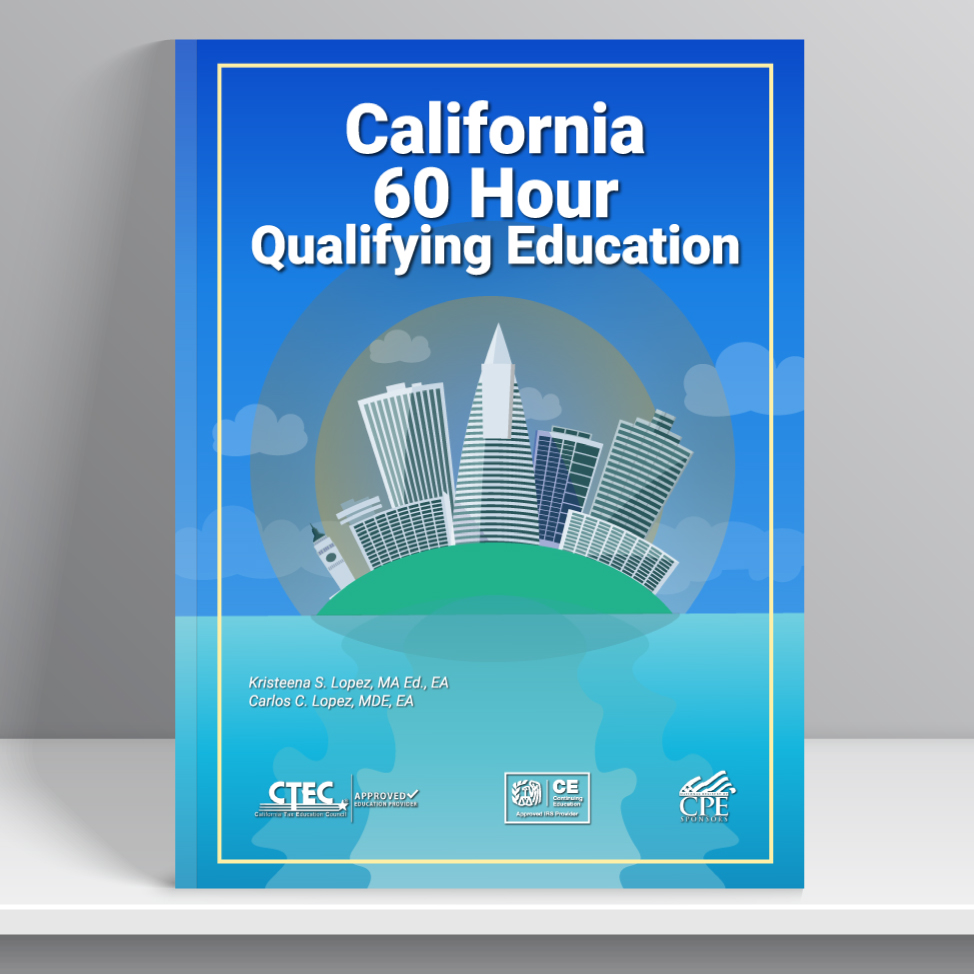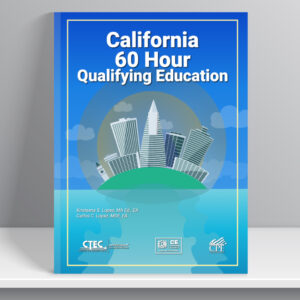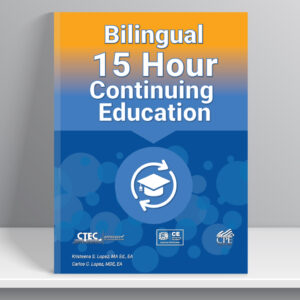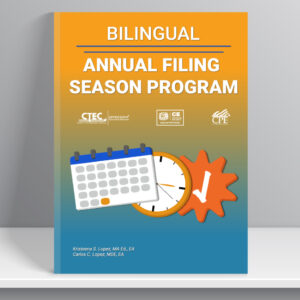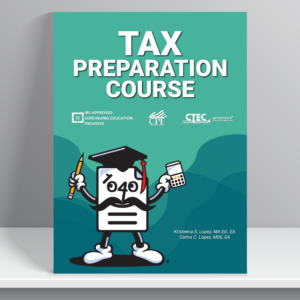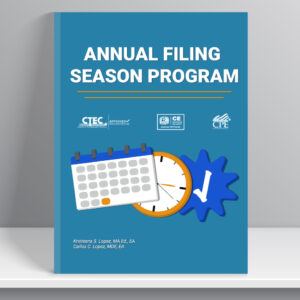Chapter 1: Due Diligence and Penalties
This chapter will cover tax preparer due diligence and penalties. When the taxpayer files a return with refundable credits the tax preparer needs to complete an accurate tax return and complete Form 8867, which is attached to the taxpayer’s return. The following refundable credits will be discussed in this course:
- Earned Income Credit (EIC).
- Child Tax Credit (CTC).
- Additional Child Tax Credit (ACTC).
- Other Dependent Credit (ODC).
- American Opportunity Tax Credit (AOTC).
Chapter 2: Compiling Taxpayer Information
The tax preparer will learn how to collect taxpayer’s information needed to prepare an accurate tax return. This course will give detailed interviewing example questions to understand how to collect the necessary information. Completing an interview to gather taxpayer’s information to understand the taxpayer’s situation to prepare an accurate tax return is an essential step.
Sample questions are provided for each section of the tax return to help the student understand the importance of knowing the “how” to and “why” ask questions to gain the necessary information from the taxpayer.
CA Compiling Taxpayers Information
The California tax return does not follow the federal return line-by-line, as established by the following:
- California subtracts the exemption amount from the tax owed.
- California did not conform to the TCJA with respect to not being able to claim an exemption for dependents.
- California begins by gathering the taxpayer’s and spouse’s personal information.
- If the couple’s status is a registered domestic partner (RDP) or same-sex married couple (SSMC), you will enter the spouse’s information on Form 540.
The information needed to complete the state return is:
- First and last name as found on SSN or ITIN.
- Address (including city, state, and zip).
- Date of birth.
- Prior name (if the taxpayer or spouse filed a prior California return with a different last name).
California does not conform to most of the federal Tax Cuts and Jobs Act changes. A tax practitioner needs to understand state tax law to make sure that the taxpayer is receiving all the credits and paying the correct amount of tax.
Chapter 3: Filing Status, Dependents and Deductions
This chapter offers a review on who qualifies for the standard deduction, and what circumstances allow taxpayers to claim a higher standard deduction. You will also learn what an exemption is, (even though it has been suspended due to TCJA). Filing status is used to determine filing requirements, standard deduction, correct tax, and taxpayer’s eligibility for certain credits and deductions. If more than one filing status applies to the taxpayer, the tax professional should choose the one that lowers the amount of tax for the taxpayer.
CA Standard Deductions, Dependents, and Filing Status
California did not conform to most of the federal Tax Cuts and Jobs Act changes. Subsequently, as a California tax preparer, you will need to make sure your software allows for the personal exemptions as required to complete the California state return.
As you have already seen, filing statuses can get very complicated at the Federal level. Unfortunately, it gets even more complicated when you include filing statuses at the state level as well. As previously stated, state law governs many aspects of the filing, like whether a taxpayer is married or legally separated under a divorce or separate maintenance decree. It is important for California tax preparers to know their state’s laws to prepare their clients’ returns as accurately and professionally as possible.
Chapter 4: Income
The IRS has the authority to tax all income from whatever source derived. This includes compensation for services, gains from dispositions of property, interest and dividends, rent and royalties, pensions and annuities, gambling winnings, and even illegal activities. All such income a person receives is collectively referred to as “worldwide income.” However, not all money or property is taxable or subject to tax. This course discusses the different types of taxable and nontaxable income and show you where and how to report such wages on a professionally prepared tax return. A tax professional must recognize the different kinds of taxable income, tax-exempt income, and other income included in Schedule 1, line 8, and must know how to figure out the taxable percentage on social security benefits.
CA Income
Although California does not conform to certain provisions of the Internal Revenue Code, it does conform in the following ways:
- The “general rule.”
- The “simplified general rule,” or the “safe harbor method.”
- IRA rollovers.
- Roth IRAs.
- Archer MSAs.
- Coverdell ESAs.
- Current-year IRA deductions.
- Lump-sum credits received by federal employees.
Chapter 5: Adjustments to Income
In this chapter, students will learn how various expenses are used to “adjust” or lower the taxpayer’s income to arrive at his or her adjusted gross income (AGI). They will also learn how the Tax Cuts and Jobs Act (TCJA) has impacted adjustments at the federal level and how to handle any previous-year returns that preceded those TCJA-mandated changes.
CA Adjustments to Income
In this chapter, you will learn what adjustments need to be made to California income and where to enter it on 540 Schedule CA. You will first review a few items from Part I, Section A, Income. Then, you will review Part I, section B, Adjustments to Income. The chapter will conclude by presenting a few items from Part II, Adjustments to Federal Itemized Deductions.
Chapter 6: Other Taxes
This chapter provides an overview of miscellaneous taxes from the Form 1040 and reported on Schedule 2 that a taxpayer might be assessed. This includes excess Social Security tax, additional taxes on IRAs, the Alternative Minimum Tax, and household employment taxes.
CA Other Taxes and Taxpayer Penalties
The Franchise Tax Board (FTB) is the agency responsible for collecting state personal income taxes in California. The revenues FTB collects are placed in the state’s general fund to help pay for items, such as roads, parks, law enforcement, and schools. California’s state income tax system is based on the principle of voluntary compliance. Voluntary compliance is a system of taxation that relies on individual citizens to properly report their income, calculate their tax liability, and file their tax returns timely.
This lesson is a brief overview of other California taxes that a taxpayer might pay as well as the types of penalties a taxpayer may pay and why.
Chapter 7: Payments and Tax Credits
A nonrefundable tax credit reduces the amount of tax liability that may have to be paid. Unlike a deduction, which reduces the amount of income that is subject to taxation, a credit directly reduces the tax itself. There are two types of credits: nonrefundable, which cannot reduce tax liability below zero, and refundable, which can reduce tax liability below zero, resulting in the need for a refund.
CA Tax Credits and Payments
Although a variety of California tax credits are available to help the taxpayer reduce their tax liability, California does not conform to all the credits that can be claimed on the federal return. This chapter will cover FTB Form 540, lines 40-48. California refers to this section as “Special Credits”. A tax preparer is responsible for ensuring (to the best of his or her knowledge) that the taxpayer is filing a true and accurate return by asking the client detailed questions and doing as much research as necessary.
Chapter 8: Itemized Deductions
When computing taxable income, personal expenses cannot be claimed as itemized deductions; however, tax rules do allow for some deductions that are essential for daily living. These specific expenses are deductible as itemized deductions. A standard deduction is a set amount that the taxpayer can claim based on his or her filing status. Itemized deductions are shown on the tax return using Schedule A, Itemized Deductions. The taxpayer must decide whether to itemize deductions or use the standard deduction and should choose whichever option is best for their tax situation.
CA Itemized Deductions
The Tax Cuts and Jobs Act made some changes to the Internal Revenue Code (IRC) that California did not adopt. California does conform with IRC regulations established on and before January 1, 2015. Because of these changes, California residents will need to make adjustments on their 540 Schedule CA to account for the differences between state and federal tax law.
Chapter 9: Schedule C
This chapter encompasses how the sole proprietor reports income. Sole proprietorship is the most popular business structure. A sole proprietorship is indistinguishable from its owner, and all income earned is reported by the owner. Schedule C is the reporting tool for most sole proprietors. Covered in the course is line by line instruction to complete the Schedule C.
Chapter 10: Schedule E
Rental income is any payment received for the use or occupation of real estate or personal property. The payment that is received is taxable to the taxpayer and is generally reported on Schedule E. Each Schedule E can report three properties. If the taxpayer has more than three properties, additional Schedule E’s would be used. Schedule E is not used to report personal income and expenses. The taxpayer should not use Schedule E to report renting personal property, that is not a business. To report other income, use Schedule 1, lines 8 – 24b.
Chapter 11: Schedule F
Income received from the operation of a farm or from rental income from a farm is taxable. Farmers determine their taxable income from farming and related activities by using Schedule F. Profit or loss from farm income is first reported on Schedule F and then “flows” to Form 1040, Schedule 1, line 6. This course covers basic farm income and expenses.
Chapter 12: Depreciation
Depreciation is an annual deduction that allows taxpayers to recover the cost or other basis of their business or investment property over a certain number of years. Depreciation is an allowance for the wear and tear, decline, or uselessness of a property and begins when a taxpayer places property in service for use in a trade or business. The property ceases to be depreciable when the taxpayer has fully recovered the property’s cost or other basis or when the property has been retired from service, whichever comes first. Depreciation is reported on Form 4562.
CA Depreciation
California law has not always conformed to federal law regarding depreciation methods, special credits, or accelerated write-offs. In general, California law conforms to the Internal Revenue Code as of January 1, 2015; however, recovery periods and basis on which depreciation is calculated may be different from the amounts used for federal purposes. Reportable differences occur if the asset was placed in service at the following times:
- Before January 1, 1987: California disallowed depreciation under the federal Accelerated Cost Recovery System (ACRS). Continue to calculate California depreciation in the same manner as in prior years for those assets.
- On or after January 1, 1987: California provides special credits and accelerated write-offs that affect the California basis for qualifying assets. California does not conform to all the changes to federal law enacted in 1993. Therefore, the California basis or recovery period may be different for some assets.
For more information regarding California and federal law that will be provided here, visit the FTB website and search for the term “conformity”.
Chapter 13: Capital Gains and Losses
This chapter includes how to calculate a short term and/or long-term gain or loss. The student will understand holding period and what is a capital asset. Almost everything a taxpayer owns and uses for personal or investment purposes is a capital asset. When a capital asset is sold, the difference between the basis in the asset and the amount the item is sold for is either a capital gain or capital loss.
CA Capital Gains and Losses
California law complies with federal law regarding capital gains and losses and requires no adjustments to complete the state return. If the California basis of the taxpayer’s assets differs from the federal, adjustments would be required using the California Schedule D. The capital gains tax rates are the same for both California and federal law. The amount of capital loss limitation for California taxpayers is also the same as the federal limitation.
Chapter 14: Electronic Filing
Electronic filing (also referred to as E-File and E-filing) is the process of submitting tax returns over the internet via properly-certified tax software. The E-File system has made tax preparation significantly easier, and the IRS notifies software users within 24-48 hours if they accepted or rejected the tax return. E-filing is not available year-round but rather begins sometime in January and ends sometime in October; the IRS determines when exactly e-filing begins and ends each year, and states follow whatever dates the IRS sets. An electronic return originator (ERO) is the individual who originates the electronic submission of the tax return. To file a return electronically, the individual needs to be an Authorized IRS e-File Provider.
CA Electronic Filing
California conforms to the federal guidelines regarding electronic filing and the importance of safeguarding the taxpayer’s personal identification information. However, California has systems in place to perform these duties at the state level, and it is important for California tax professionals to know them and how they are different. For more information, see California Revenue & Taxation Code Sections 18621.9 and 19170.
Chapter 15: Extensions and Amendments
If taxpayers are unable to file their federal individual tax returns by the due date, he or she may be able to qualify for an automatic six-month extension of time to file. The taxpayer can either electronically file or mail Form 4868 to the IRS to file for the extension. If the taxpayer has filed a return and realizes that a mistake was made, he or she would file an amended return by using Form 1040-X.
CA Extensions and Amendments
If taxpayers are unable to file their California individual tax return by the due date, they may be able to qualify for an automatic six-month extension of time to file by electronically filing or mailing Form 3519 to the FTB. If the taxpayer has filed a return and realizes that a mistake was made, he or she would have to file an amended return using Schedule X.
| Course Details | Included in this course |
| Title: 2024 CTEC 60 Hour Qualifying Education Level: Beginner Delivery Method: Self-study CTEC Vendor: #2080To earn a certificate of completion:
|
|
All CTEC Registered Tax Preparers (CRTP) must
|
|
This course has been approved by the California Tax Education Council (2080-QE-001), which fulfills the 60-hour qualifying education requirement imposed by the state of California to become a tax preparer. A listing of additional requirements to register as a tax preparer may be obtained by contacting CTEC at P.O. Box 2890, Sacramento, CA, 95812-2890 or 1-877-850-2832 or www.CTEC.org.

